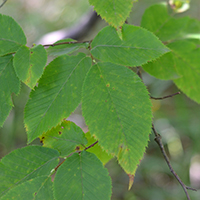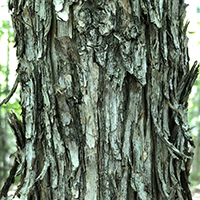What ironwood looks like
Size and shape
- Reaches 12 metres high.
- Trunk up to 25 centimetres in diameter.
Leaves
- Oval-shaped (7 to 12 centimetres) with toothed edges and a pointed tip.
- Dark yellowish-green.
- Are progressively larger near the tip of a growing shoot.
- Turn yellow in fall.
Bark
- Greyish-brown.
- Short, peeling vertical strips.
Flowers
- Male flowers grow as catkins in groups of 2 or 3 (15 to 50 millimetres).
- Female flowers grow in clusters known as racemes.
- Bloom in April and May.
Fruit
- Flattened nut (5 to 8 millimetres) enclosed by an inflated sac (15 millimetres) and covered in stiff hairs.
- Nuts grow in clusters.
Where ironwood is found
Ironwood trees are found in Southern Ontario, north to Lake Nipissing and Sault Ste. Marie. Populations are also found in the Lake of the Woods region in Northwestern Ontario.
What you need to know to grow ironwood
- Moisture: grows best in well-drained soil, intolerant of flooding.
- Soil: tolerant of most soil types.
- Shade: grows well in all conditions, from deep shade to full sun.
- Caution: ironwood trees cannot tolerate pollution or road salt and should be planted away from busy roads.
Benefits and uses of ironwood
Wildlife benefits
Ironwood twigs, catkins and seeds are a food source for many birds and mammals, including:
- white-tailed deer
- red squirrels
- ruffed grouse
- rose-breasted grosbeak
Commercial uses
Ironwood timber is hard and dense, making it useful for:
- tools
- handles
- fence posts
- mallets
The wood is also a good fuel source but can be tough to split.
Fun facts about ironwood
- Ironwood trees have the hardest and densest wood of any Canadian species.
- The fruit resemble clusters of hops, hence its common name hop-hornbeam.
Updated: November 22, 2023
Published: July 18, 2014




